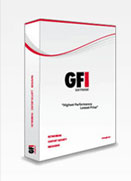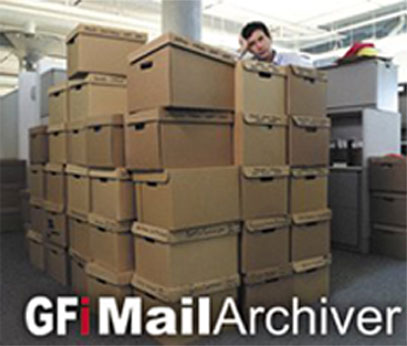|
|
|
|
|
|
|
|
|
|
|
|
|
|
|
|||||||
 |
 |
|
||||||||||||||||||
|
|
|
|
GFi Mail Archiver for ExchangeNEW! In GFi MailNEW! – Multi-lingual Support for indexing emailsThe new version ships with multi-lingual support. During installation of GFI MailArchiver, administrators have an option to select the language/word breaker to be used when indexing emails. This is useful for customers or organizations who receive emails in the following languages: English, Dutch, French, German, Italian, Russian, Spanish, Czech, Arabic, Hebrew, Japanese, Korean, Traditional Chinese and Simplified Chinese. NEW! – Integration with Exchange and other email serversGFI MailArchiver leverages the journaling feature of Exchange Server, providing unparalleled scalability and reliability. Other email archiving solutions actually replace the email with a link to their database – this can be a point of failure and can bring down your entire email system. GFI MailArchiver works in parallel and does not touch the way Exchange works. GFI MailArchiver can be used with Exchange as well as other email servers with the capability of polling emails from a mail server which supports IMAP and Active Directory. NEW! – Outlook integration – with industry first non-stubbing technologyIntegration with Outlook means that archived email can be accessed from Outlook as if it were in an Exchange mailbox or a local PST file. While other products offer Outlook integration, GFI MailArchiver does so without using stub files; a method that is discouraged by Microsoft and which creates problems for administrators because small portions of emails are still left in the Exchange Server store, thus having a negative effect on server performance. GFI MailArchiver’s non-stub approach to Outlook integration is an industry first and the software also provides administrators with full real-time synchronization of all folders/mails in the Exchange mailbox. Automatically archive corporate email into one storage areaYour mail server is not the ideal place to store all organizational email: Over time this will cause a severe decline in email performance. Moving old emails into a database will keep your mail server performance high and email stores compact. You may archive your email in: * A SQL database: Because email is stored in a standard SQL database, it is easy to backup and restore; no special Exchange backup tools are required. This setup is strongly recommended for high email volume environments. * Directly to an NTFS hard drive: You may store email in a database that is located on an NTFS-formatted hard drive, saving you the license costs of Microsoft SQL Server! This setup is suitable for low email volume environments and for small enterprises intending to save on license costs of Microsoft SQL Server. Multiple database support and ‘automatic’ database management supportIt is possible to archive emails in multiple databases – this overrides the problem of having one large database that becomes slow and requires more maintenance. GFI MailArchiver allows you to automatically archive emails to a new database after a specified time, for example, every month or quarter. Reduce email storage requirementsGFI MailArchiver compresses and decompresses attachments on the fly, which results in considerable savings in terms of storage when compared to storing attachments in the Exchange stores. In addition, storing email in a database is more space efficient than storing in PST files. An added advantage is that GFI MailArchiver archives only one copy of attachments sent to multiple recipients. End PST hellUsing GFI MailArchiver for Exchange eliminates the need for users to archive their mail in PST files on local hard disks. These PST files end up being very large and are difficult to backup and search. Many users do not know how to organize their PST files properly. With GFI MailArchiver, users can browse to the web search interface and retrieve past email from the database, rather than having to dig through a store of PST files on disk to find a particular email. Migrate old PST files stored on client machinesThrough GFI MailArchiver's agent-based PST Exporter, you can archive emails processed by Microsoft Exchange prior to the installation of GFI MailArchiver. The GFI PST Exporter uses the GFI MailArchiver Import Service to transfer emails to an archive store without any end-user intervention. Agents save extracted emails in a destination folder and the GFI MailArchiver Import Service then imports the extracted emails into a GFI MailArchiver archive store. Set up email retention and categorization policiesSetting up an email retention policy is critical and while email archiving is essential, retaining emails for an indefinite time is costly! With GFI MailArchiver you can create rules to delete one or more emails after a specific time, for example, you can delete all emails sent by the Marketing Department that are older than 7 years. In addition, GFI MailArchiver can help you to categorize emails by adding a label to the emails that meet a particular condition. For example, emails sent from the CEO, could be automatically labelled with [CEO]. Helps comply with Sarbanes-Oxley ActBy archiving all company email, GFI MailArchiver helps organizations to meet regulatory compliance such as the Sarbanes-Oxley Act. Under the Sarbanes-Oxley Act 2002 and Security and Exchange Commission (SEC) rules, public companies must prove that their internal controls and audit trails are sound and that their processes are capable of producing certifiably correct data. Companies must retain all correspondence created, sent, or received "in connection with an audit or review" of a public company for a period of seven years, during which time these records must be non-erasable and non-rewritable. This includes any "electronic records" such as email, particularly relating to subjects, departments or individuals involved in auditing procedures. Failure to comply is a crime, punishable by up to 10 years in jail. Helps to comply to other acts and regulationsGFI MailArchiver is also a valuable tool that aids compliance with the following: E-Comm Act 2000, BS7799-2:2002, Enterprise Act 2002, Decreto del Presidente del Consiglio dei Ministri (8 febbraio 1999) and more. Give viewing rights and exempt users from archiving emailGFI MailArchiver allows you to grant a user viewing rights to all email relating to a specific Active Directory Group, for example, the Sales Manager would be able to view all emails sent or received by his team. Also, if required, you can instruct GFI MailArchiver for Exchange not to archive email to/from particular users, for instance it is possible not to archive emails sent to/from the HR Manager. View screenshot. Collect and archive emails in one geographical locationGFI MailArchiver provides the possibility of centralizing email archiving to one physical location by polling emails from multiple locations. For example, an organization that operates in the US, UK and Australia may want to archive email of all offices centrally in one location – the US office. View screenshot. Audit your archived email to ensure they have not been tamperedGFI MailArchiver ships with auditing functionality that ensures all archived emails have not been tampered with. This is particularly important in industries and countries where regulations require organizations to monitor user activity and keep audit trails of such activity. GFI MailArchiver offers two types of auditing: * Database activity auditing: Uses the tracing capabilities of Microsoft SQL Server to record all activity affecting the GFI MailArchiver archive databases. * User interaction auditing: Record all users’ activity whilst they are using the GFI MailArchiver web interface to browse email archive stores. Features for the userAccess emails from any location through a browserGFI MailArchiver allows users to access their emails from anywhere in the world by using a browser. Emails that had been deleted may also be seen (and restored). Advanced email search and 'Saved Search' capabilitiesHaving a central store of email enables users to easily search through their past email and attachments (Microsoft Word, Excel, PDF, ZIP and many other formats). Once a search has been defined, the user has the possibility to save the search criteria for easy reference at a later date, similar to Microsoft Outlook Search Folders. For example, you may save a search that displays all email correspondence with client X. OneClick Restore a single email to a mailboxBy simply clicking on a button, the user or the administrator can restore an email to a user’s inbox in its original format. GFI MailArchiver restores any archived email (even deleted email) and these are resent to the user as an attachment. Other features:* Printer-friendly support for printing emails |
|
||||||||||||||||
 |
|
|||||||||||||||||||
|
|
||||||||||||||||||||
|
|
||||||||||||||||||||
 |
|
|||||||||||||||||||
|
|
||||||||||||||||||||
|
|
- TEL: +46-31 918960 - FAX: +46-31 918832 - www.dck.se |
|
 |
|
||||||||||||||||
 |
|
|
|
|||||||||||||||||
|
|
|
|
|
|
|
|
|
|
|
|
|
|
|
|
|
|
|
|
|
|